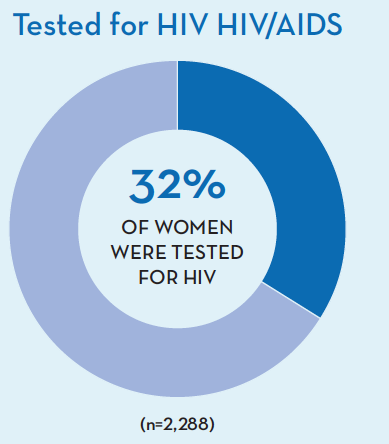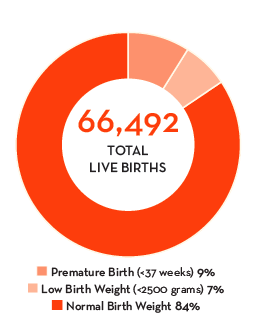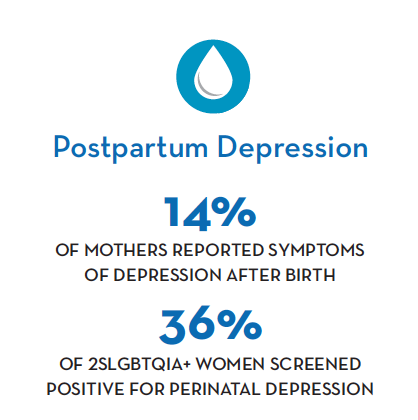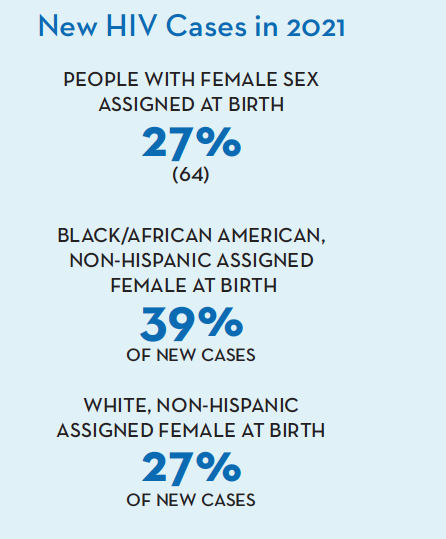(Sources: Much of the data in this section are retrieved from the 2020 MN health statistics annual summary available here).

In 2020, the state counted 72,039 pregnancies to MN residents, 79.8% were from birthing people of U.S. origin, and 20.2% were from birthing people of foreign origin (source). The pregnancy rate was 66.2 per 1,000 females ages 15-44).
2020 Singleton and Multigestational Births

Healthy People 2030 reduced the number of objectives to prioritize the most pressing public health issues. Low birthweight and very-low birthweight targets were in the objectives that were removed.
- Healthy People 2030 targets (source)
- Total preterm birth: 9.4%

For more information on Family Planning in MN, refer to this 2019 report from MN DHS.
Maternal Mortality in MN
In 2022, MDH released its first-ever MN Maternal Mortality Report, which examined maternal deaths during pregnancy or within one year of the end of pregnancy, irrespective of cause from 2017 to 2018. While the report shows the state’s overall maternal mortality rate is much lower than the national average, it revealed the stark disparities in maternal mortality, especially among Black and American Indian Minnesotans. Black Minnesotans represent 13% of the birthing population but make up 23% of pregnancy-associated deaths, and American Indian Minnesotans represent 2% of the birthing population, but 8% of pregnancy-associated deaths (source).
Gestational Diabetes and Sexually Transmitted Infections (STIs)


Among females in MN, the highest percentage of syphilis was found in White non-Hispanic individuals (45%), followed by Black non-Hispanic (20%) and American Indian individuals (20%).

An outbreak was declared in the Duluth area in September 2019 and continues. The annual number of diagnoses is listed below for each year (source):
- 2019: 1,105
- 2020: 1,088
- 2021: 1,447
HIV/AIDS

- % of females ever tested for HIV went from 36% to 32% since 2020 MN-WHRC (n=2,288) (source).
- In 2021, 64 people assigned female at birth were diagnosed with HIV, which was about 27% of total cases in the state (source), of these cases in people assigned female at birth, 39% were Black or African American of non-Hispanic descent and 27% were White, non-Hispanic (source).
- For more information on HIV and PrEP access and experiences in MN, refer to this 2021 Rainbow Health Voices of Health report.
Health status for postpartum care
- Private insurance: 72.9% (17.7% increase)
- Medicaid: 19.4% (9.7% decrease)
- No insurance: 1.6 % (13.3% decrease)
The numbers reported here come from MDH and were also retrieved from the 2020 MN Health Statistics Annual Summary and the CDC BRFSS). They include the sexually transmitted infections (STIs) reported in different services throughout the state. It should be noted that the All Payers Claim Database would be a better resource to capture the number of individuals tested.
Details/Sources
- Fertility rate: 58.4 births per 1,000 (women ages 15-44 years) (source)
- Crude birth rate: 11.2 per 1,000 total population (source)
- Birth rate: 11.2 per 1,000 population (source)
- 79.2% of pregnant people received prenatal care in the first trimester (source)
- 13.8% of mothers reported symptoms of depression after birth in 2020 (source)
- 35.6 % of sexual minority women screened positive for perinatal depression (source)
- 24.9% of women were obese pre-pregnancy in 2020 (source)


